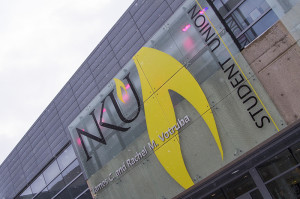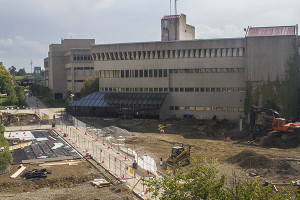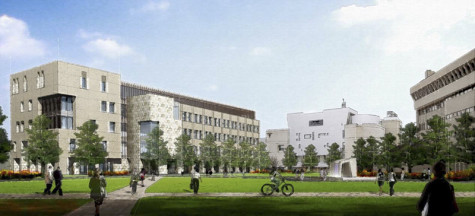Your donation will support the student journalists of Northern Kentucky University. Your contribution will allow us to purchase equipment and cover our annual website hosting costs.
NKU raises its bar for sustainable construction standards
December 28, 2014
NKU is taking advantage of its recent and continued growth through implementing more environmentally sustainable construction and renovation practices in projects all across campus.
Though construction and renovation usually bring about negative effects on the environment, NKU is taking this opportunity to set a new bar for sustainable design and construction.
The university recently sent out a request soliciting bids for the forthcoming Health Innovations Center, which showcased a required minimum LEED Silver Certification in design for the new building.
LEED, or Leadership in Energy & Environmental Design, is a green building certification program that recognizes best-in-class building strategies and practices, according to U.S. Green Building Council.
To receive LEED certification, building projects satisfy prerequisites and earn points to achieve different levels of certification
What exactly do LEED Silver and Gold Certifications mean? And how do these certifications rank on the green building continuum?
LEED Certification can meet four different levels of distinction:

LEED Platinum Certification— 80 or greater credits
LEED Gold Certification— 60-79 credits
LEED Silver Certification— 50-59 credits
LEED Certification— 40-49 credits
The distinctions are ranked according to possible credit categories below:
1- Integrative Process
2- Location and Transportation
3- Materials and Resources
4- Water efficiency
5- Energy and atmosphere
6- Sustainable sites
7- Indoor environmental quality
8- Innovation
9- Regional Priority Credits
University President Geoffrey Mearns said this Silver Certification has become a minimum requirement for new construction across campus and that a LEED Gold Certification is being sought out for the new Health Innovations Center building as a new preferred, but not required, minimum for sustainable construction and design standards on campus.
He said the university hopes to have at least that same LEED Silver Certification bar met for any renovations or reconstructions that take place across campus in the coming years.
Recent construction and renovations projects are as follows:
2008
Callahan Hall — the 434-bed residence hall is created in a renovated retirement home, saving the costs and materials otherwise associated with a new construction

Student Union — the 150,000-square-foot building has low-energy mechanical and lighting systems, glass that cuts down on heat gain and concrete made with recycled fly ash. (This facility was built before the state government mandated that projects of over $25 million had to be designed to be LEED Silver.
Bank of Kentucky Center — the 243,000 square-foot multi-purpose event center, is a significant energy consumer
2011
Griffin Hall — the building achieved LEED Silver certification, and is NKU’s first LEED certified building.
2014

University Plaza — the renovated plaza reduced the square footage of impermeable surfaces in the center of campus, which includes a large green roof.
Norse Commons — the renovation to the campus dining facility was not designed to meet LEED certifications.
Northern Terrace — the newest residence hall lies within a former senior living center, saving the costs and materials otherwise associated with a new construction
Ongoing
Campus Recreation Center — the renovation of the campus recreation center, and upgrades to existing HVAC and other infrastructure as needed to achieve code compliance, LEED Silver certification (or gold) and to improve occupant comfort

Planned
Health Innovations Center — the new construction will potentially be LEED Gold certified, or a minimum of LEED Silver certified, including a potential LEED certified renovation of the to-be connected Founders Hall.
Sustainable planning is key to a ‘greener,’ more responsible campus
While Mearns noted the university’s commitment to sustainability is even now a part of the university’s new strategic plan, others at the university have seen sustainability as a part of the campus planning process for decades.
“The interesting thing is that the university was always been interested in sustainability and it has always been our priority to design the buildings for energy efficiency and for the campus to operate efficiently,” Mary Paula Schuh, director of university planning, said.
Schuh has been at NKU for 35 years and has seen the university grow tremendously in that time.
Nunn Hall, Founders Hall and Regents Hall were the first three buildings, according to Schuh. The fourth buildings were the library and the power plant, simultaneously. She said people call it the power plant but that it really is a steam and chilled water plant. From then on all the academic buildings were connected to the steam and chilled water plant.
“That is a very efficient way to operate the campus,” Schuh said.
At this point, all of the academic buildings, including The Bank of Kentucky Center, operate with chilled water and steam from the central plant.
Various other aspects of the campus have also been considered for their efficiency in the distant past.
The first several buildings didn’t have double-paned windows, but that changed and then became standard, according to Schuh.
Perhaps, however, the most visible and prominent example of the university’s commitment is the new Health Innovations Center project, Mearns said.
“If we are able to get LEED Silver or LEED Gold with the entire renovation we will then have done something even more substantial which is taking an older building which did not meet those sustainability standards and meeting that higher standard as well and that’s a real challenge.”
While the construction initiatives the university is taking is pushing the university in the right direction, according to University Planner and NKU Green representative Jane Goode, the issue ultimately boils down to creating a culture of sustainability on campus.
“Since I have been here, I have a really always wanted to have the campus have a culture of sustainability,” Goode said. “You know, there are some people who are really conscious and some people who are unconscious. I would like to wake people up to be active participants for sustainability.”
Not that it causes them problems in getting through their lives, but it actually makes them more conscious of being alive and participating in the world. I think it is so easy to be oblivious and think that what you personally do is unimportant. But, I think living sustainability is important.”
